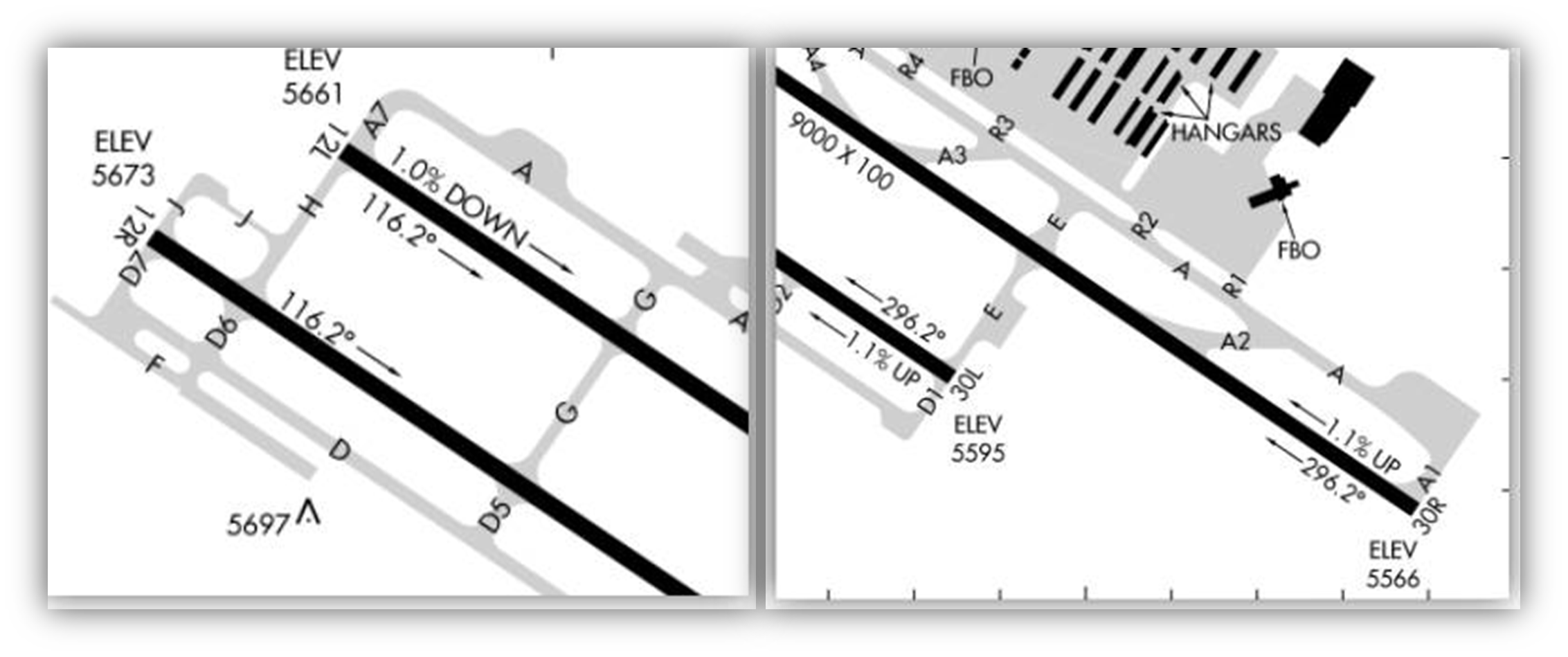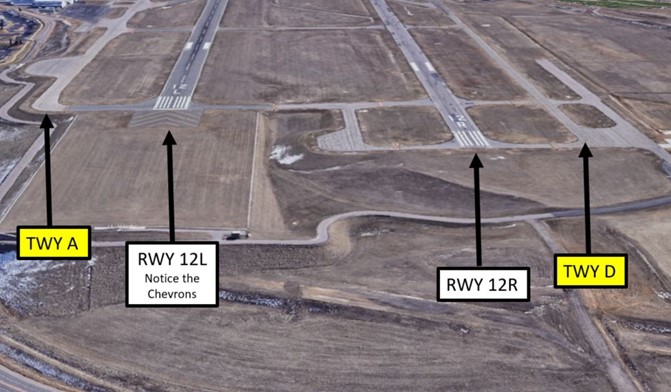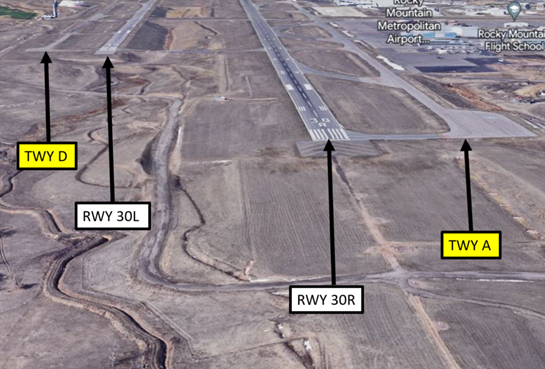Rocky Mountain Metropolitan Airport (BJC)
Rocky Mountain Metropolitan Airport (BJC) is a medium sized, multi-use airport located 20 miles west of the Denver International Airport. Situated on the northwest edge of the metropolitan area, it provides a convenient alternative to Business and General Aviation pilots visiting the Denver area. A complex airport layout coupled with the wide diversity of pilot experience and aircraft performance makes Rocky Mountain Metropolitan a challenge to both pilots and controllers. View a printable Pilot Handbook of the BJC information found on this Web page.
Know Before You Go
- The diverse traffic mix at BJC includes basic flight school instruction (both fixed and rotor-wing), high-end corporate, air taxi, transient, military, and forest-service firefighting aircraft.
- There are two parallel, staggered RWYs 12R/30L and 12L/30R with intersecting RWY 03/21.
- All parking and businesses are located on the north side of the parallel RWYS.
- First-time pilots have reported difficulty in finding the airport due to surrounding terrain.
- A helpful landmark is a set of two large and one small water tanks located on the south side of the airport. They are painted white and orange and are generally easily seen.
- Wrong Runway Landing risk exists due to closely spaced, staggered, parallel RWYs.

- Pilots may receive complex taxi instructions after landing partly due to intense helicopter operations at Hot Spot 1 and TWY D.
- Remain on TWR frequency while on TWY D until advised to change.
- RWY 03 is often utilized as a taxi route while helicopter training may be in progress at the approach end of RWY 21.
- Several frequency changes due to the division of ground and tower controller responsibility adds to the ground operations complexity at BJC.
- At Hot Spot 2, numerous Hold Short Lines occur in quick succession.
- Aircraft cleared to taxi via D, B, hold short of RWY 12R, will cross two (two) sets of Hold Short Lines for RWY 03/21 before reaching RWY 12R/30L. This has been a source of confusion. If in doubt, hold short and ask.
- Some Hold Short Lines occur further back from the RWYs they protect and pilots may not be aware of this.
- Aircraft landing on the RWY 12R/30L and told to hold short of RWY 12L/30R must completely clear the RWY 12R/30L Hold Short Line before holding short of RWY 12L/30R.
- Departing aircraft stopped in the run-up area on TWY A on the way to RWY 12L do not need to call contact TWR to continue taxiing to RWY 12L for departure.
- Aircraft should continue to monitor TWR frequency while in the run-up are before moving to the RWY 12L Hold Short Line.
- Call TWR when Holding Short either at the Hold Line or in sequence behind another aircraft.
- Aircraft holding short of RWY 12L for departure, are sometimes instructed to cross RWY 12L and depart RWY 12R due to traffic. If this happens, it is critical that pilots cross RWY 12L without delay.
- At Hot Spot 3, pilots taxiing south on TWY D, and instructed to cross RWY 03, mistakenly make the turn onto RWY 03.
- Also at Hot Spot 3, pilots already taxiing on RWY 03, and instructed to hold short of RWY 12R/30L fail to hold short.
- This hold line is immediately after the turn onto RWY 03.
Below find various BJC-specific information and things to be aware of, as well as general information to inform your preflight planning. This will be reviewed quarterly and updated as needed. This information is to supplement the From the Flight Deck Videos that are produced by the FAA Runway Safety Group. Here you will also find information provided by the local air traffic controllers at the airport where you intend to fly. The information is subject to change. Not for navigation or legal* pre-flight action. Always refer to official pre-flight materials such as, but not limited to, NOTAMs, airport diagrams, VFR charts and airport construction notices for the latest airport-specific details.
BJC Tower Administrative Office
Business Phone 720-633-8600
Open 0700L to 1530L – Monday through Friday
The airspace at BJC is Class D with a ceiling up to but not including 8000’ MSL. It partially underlies DEN Class B airspace which begins at 8000’ MSL immediately east of the airport. BJC underlies the DEN MODE C & ADS-B OUT 30 NM veil. (Refer to Sectional Chart)
Class D Airspace Requirements (CFR §91.129 and AIM 3-1-4; 3-2-5):
| Visibility | 3 statute miles |
| Distance from Clouds | 500 feet below | 1,000 ft above | 2,000 ft horizontal |
| Communications | Establish communications (controller response) |
| Pilot | No special certification required |
| Equipment | Two-way radio |
Class B Airspace Requirements (CFR §91.131 and AIM 3-1-4; 3-2-3):
| Visibility | 3 statute miles |
| Distance from Clouds | Clear of clouds |
| Communications | Must obtain ATC clearance prior to entering/departing |
| Pilot | Private Pilot Certificate (see AIM for alt requirements) |
| Equipment | Two-way radio, operable transponder with automatic altitude reporting and ADS-B Out |
Hot Spots
HS 1 Frequent helicopter operations on north ends of TWY B and RWY 03/21.
Use caution in this area.
HS 2 Multiple hold lines in close proximity. Hold line on TWY B south of RWY 12R/
30L is prior to TWY D. Pilots should use caution and hold short when
instructed by ATC.
HS 3 Pilots taxiing south on TWY D and instructed to cross RWY 03 mistakenly turn
onto RWY 03. Pilots taxiing on RWY 03 and instructed to hold short of RWY
12R/30L fail to hold short. Hold line immediately after turn onto RWY 03.
Departure
- Verify proper heading prior to starting takeoff roll on all departures.
- Departing aircraft stopped in the run-up area on TWY A, on the way to RWY 12L, do not need to call contact TWR to continue taxiing to RWY 12L for departure.
- Aircraft should continue to monitor TWR frequency while in the run-up and before moving to the RWY 12L Hold Short Line.
- Call TWR when Holding Short either at the Hold Line or in sequence behind another aircraft.
- Aircraft, holding short of RWY 12L for departure, are sometimes instructed to cross RWY 12L and depart RWY 12R due to traffic. If this happens, it is critical that pilots cross RWY 12L without delay.
Landing
- Aircraft landing on the RWY 12R/30L and told to hold short of RWY 12L/30R must completely clear the RWY 12R/30L Hold Short Line.
- Pilots may receive complex taxi instructions after landing partly due to intense helicopter operations at Hot Spot 1 and TWY D.
- RWY 12R/30L and RWY 12L/30R are closely spaced parallel RWYs with staggered thresholds.
- Be aware that a Wrong Runway Landing risk exists.


Surface Risk – Movement Area
- Remain on TWR frequency while on TWY D until advised to change.
- RWY 03 is often utilized as a taxi route while helicopter training may be in progress at the approach end of RWY 21.
- Several frequency changes due to the division of ground and tower controller responsibility adds to the ground operations complexity at BJC.
- At Hot Spot 2, numerous Hold Short Lines occur in quick succession.
- Aircraft cleared to taxi via D, B, hold short of RWY 12R, will cross two (2) sets of Hold Short Lines for RWY 03/21 before reaching RWY 12R/30L. This has been a source of confusion. If in doubt, hold short and ask.
- Be aware that some Hold Short Lines occur further back from the RWYs they protect.
- At Hot Spot 3, pilots taxiing south on TWY D, and instructed to cross RWY 03, mistakenly make the turn onto RWY 03.
- Also at Hot Spot 3, pilots already taxiing on RWY 03, and instructed to hold short of RWY 12R/30L fail to hold short.
- This hold line is immediately after the turn onto RWY 03.
Additional Cautions
- Helicopter arrival/departure from RWYs and TWYs.
- See Special Notices – Extensive Helicopter Flight Training. USAF 306 Flight Training Group Flight Training Areas, vicinity of Colorado Springs and Pueblo Colorado.
- Numerous flight schools.
- First-time pilots have reported difficulty in finding the airport due to surrounding terrain.
- If ever in doubt about your position or your instructions, ask the TWR.
BJC Tower (TWR) operates from 0600L to 2200L
When TWR is closed:
- The airspace becomes Class G
- Use CTAF 118.6
- Use CTAF to control Runway lighting when TWR is closed.
- When TWR is closed fly Right Traffic Patterns on RWYs 30R, 12R and 21.
- When TWR is operational follow TWR instructions.
- When TWR is operational follow TWR instructions.
General
- Initial calls on any frequency should include full call-sign with type, position, intentions or requests. Be specific on the type of pattern work requested, rather than asking for “pattern work” or “patterns.”
- Runway crossings should all be done expeditiously.
- If there is ever confusion with any ATC instruction, ask for reissue of instructions by stating “say again” or just state you do not understand the instructions.
Traffic Patterns
- Always keep the aircraft you are following in sight to the maximum extent possible. If you lose sight of your sequence, immediately ask tower to call the traffic so that you may identify your sequence to the runway.
- Do not turn base if you lose sight of your traffic sequence in the pattern. Advise ATC immediately.
- The traffic pattern is 6500’ MSL.
- Once completed with traffic pattern and holding short between the active runways, never switch frequencies until instructed by ATC.
Ground
- When ready to taxi out to the active runway contact Ground Control 121.7 when aircraft is approaching taxiway A from ramp. Refrain from calling Ground Control for instructions while still at the flight school area.
- When vacating a runway, do not taxi onto active taxiway without establishing two-way communication with Ground Control.
- In addition, once aircraft is holding-short of the taxiway contact Ground Control ASAP stating your full call sign and parking request.
- Please refrain from performing checklists and discussions while holding short of the taxiway due to the necessity of ATC to keep connectors clear.
Takeoff/Departure
- Verify proper heading prior to starting takeoff roll on all departures.
- Monitor the tower frequency 118.6 as you taxi up to the hold-short line of the active runway, when number 1 in line promptly state your full call sign and intention
Arrival/Landing
- When performing a VFR practice approach, on initial call state your full call sign, position and how the approach will terminate i.e. Full Stop, Low-Approach with direction of departure etc.
- Noise abatement procedure in effect. Noise office 303-271-4850.
- Pilots are requested to avoid flight due to nesting eagles:
- Below 6500’ MSL – BJC 025/2.7
- Over Standley Lake below 8000’ MSL – BJC 150/3
- TWY C1 and TWY D marked with reflectors.
- North terminal ramp exceeds recommended standard.
